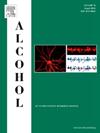评估眼窝额叶皮质体积作为青少年早期对酒精主观反应的预测因子
IF 2.9
4区 医学
Q3 PHARMACOLOGY & PHARMACY
引用次数: 0
摘要
青春期是大脑结构个体差异可能影响酒精使用行为出现的关键时期。眶额皮质(OFC),一个涉及奖励处理和行为调节的区域,可能在形成对酒精的早期反应中起关键作用。这项研究调查了9-10岁时OFC体积较小是否预示着13-14岁时经历酒精主观影响的可能性。参与者(N = 206, 57%为女性)来自青少年大脑认知发展研究。使用基线内侧和外侧OFC体积。在随访期间使用二元结果(1 =有影响,0 =无影响)测量对酒精的主观反应。混合效应logistic回归模型检验了OFC和酒精反应之间的关系,调整了性别、父母教育程度、种族/民族、颅内容量和部位。基线时左侧内侧OFC较小与报告主观影响的几率较大显著相关(OR = 1.70, p = 0.026)。报告主观影响的年轻人在过去一年中也消耗了更多的酒精(p < .001),但他们的酒精期望值没有差异。在报告主观影响的人群中,OFC量与饮酒的数量或频率无显著相关性。这些发现表明,较小的OFC体积可能并不反映药物敏感性本身,而是与早期饮酒行为有关,足以引起明显的影响。这可能反映了潜在的冲动相关特征或改变的神经发育轨迹,这些特征使年轻人更容易出现早期和潜在的高风险饮酒模式。研究结果强调了识别导致青少年饮酒个体脆弱性的大脑结构标记的潜在价值。本文章由计算机程序翻译,如有差异,请以英文原文为准。
Assessing orbitofrontal cortex volume as a predictor of subjective response to alcohol during early adolescence
Adolescence marks a critical window wherein individual differences in brain structure may influence the emergence of alcohol use behaviors. The orbitofrontal cortex (OFC), a region involved in reward processing and behavioral regulation, may play a key role in shaping early responses to alcohol. This study examined whether smaller OFC volume at ages 9–10 predicted likelihood of experiencing subjective effects of alcohol by ages 13–14. Participants (N = 206; 57 % female) were drawn from the Adolescent Brain Cognitive Development Study. Baseline medial and lateral OFC volumes were used. Subjective response to alcohol was measured during follow-up using a binary outcome (1 = any effect, 0 = no effects). Mixed-effects logistic regression models tested the association between OFC and alcohol response, adjusting for sex, parental education, race/ethnicity, intracranial volume, and site. Smaller left medial OFC at Baseline was significantly associated with greater odds of reporting subjective effects (OR = 1.70, p = .026). Youth who reported subjective effects also consumed more alcohol in the past year (p < .001), but did not differ in their alcohol expectancies. Among those reporting subjective effects, OFC volume was not significantly associated with the amount or frequency of alcohol use. These findings suggest that smaller OFC volume may not reflect pharmacological sensitivity per se, but instead relate to early drinking behavior sufficient to elicit noticeable effects. This may reflect underlying impulsivity-related traits or altered neurodevelopmental trajectories that predispose youth to early and potentially riskier patterns of alcohol use. Results underscore the potential value of identifying structural brain markers that contribute to individual vulnerability for alcohol use during adolescence.
求助全文
通过发布文献求助,成功后即可免费获取论文全文。
去求助
来源期刊

Alcohol
医学-毒理学
CiteScore
4.60
自引率
4.30%
发文量
74
审稿时长
15.6 weeks
期刊介绍:
Alcohol is an international, peer-reviewed journal that is devoted to publishing multi-disciplinary biomedical research on all aspects of the actions or effects of alcohol on the nervous system or on other organ systems. Emphasis is given to studies into the causes and consequences of alcohol abuse and alcoholism, and biomedical aspects of diagnosis, etiology, treatment or prevention of alcohol-related health effects.
Intended for both research scientists and practicing clinicians, the journal publishes original research on the neurobiological, neurobehavioral, and pathophysiological processes associated with alcohol drinking, alcohol abuse, alcohol-seeking behavior, tolerance, dependence, withdrawal, protracted abstinence, and relapse. In addition, the journal reports studies on the effects alcohol on brain mechanisms of neuroplasticity over the life span, biological factors associated with adolescent alcohol abuse, pharmacotherapeutic strategies in the treatment of alcoholism, biological and biochemical markers of alcohol abuse and alcoholism, pathological effects of uncontrolled drinking, biomedical and molecular factors in the effects on liver, immune system, and other organ systems, and biomedical aspects of fetal alcohol spectrum disorder including mechanisms of damage, diagnosis and early detection, treatment, and prevention. Articles are published from all levels of biomedical inquiry, including the following: molecular and cellular studies of alcohol''s actions in vitro and in vivo; animal model studies of genetic, pharmacological, behavioral, developmental or pathophysiological aspects of alcohol; human studies of genetic, behavioral, cognitive, neuroimaging, or pathological aspects of alcohol drinking; clinical studies of diagnosis (including dual diagnosis), treatment, prevention, and epidemiology. The journal will publish 9 issues per year; the accepted abbreviation for Alcohol for bibliographic citation is Alcohol.
 求助内容:
求助内容: 应助结果提醒方式:
应助结果提醒方式:


